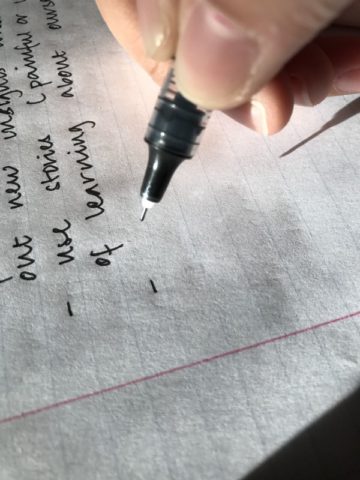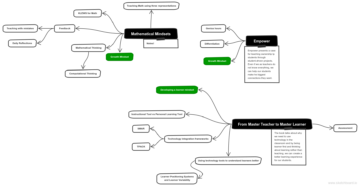We want to cater to student needs and interests while teaching to make education relatable, meaningful, enjoyable as well as accessible.
An integral part of being a teacher is developing lesson plans which represent how teaching will be taken in the classroom. Lesson plans break down the class into little chunks of playing attention to the teacher, working in groups or individually, discussions and so on. The objectives of the syllabus the class time is dedicated to, questions the teacher will focus on as well as any videos or multimedia that will be shown are the content; the activity that the students will do and class discussions form the process; and the worksheet for the day or any artifact that needs to be handed in to show the progress through the lesson is the product. I have been reading Carol Ann Tomlinson’s How to Differentiate Instruction in Mixed-Ability Classrooms and it has given me a new perspective on approaching lesson plans.

As a preservice teacher, I often struggle with making lesson plans because I do not know the students — I don’t have any students — so how do I build lesson plans that will cater to their needs? I have learned through my education that I do not have to. I can create lesson plans without knowing the students, building a general idea of the activities I want to do, while keeping in mind that:
- the lesson will change based on the student group that I have;
- the lesson I create right now is a way to keep my ideas together and hone over time;
- since I want to reach every student, I have to be aware of and incorporate as many different learning styles as possible into my lessons.
As I will get to know my students, I will be able to tweak my lesson plans and the way I teach for the class as a whole as well as the students individually. This individualized instruction is known as differentiated instruction. It is a proactive planning process that expresses the material in multiple ways and also allows learning to be showcased in multiple ways. It allows for the use of group work, individual work as well as whole class work as opportunities arise. It is a qualitative approach to teaching — the aim is to ensure the student gets the most out of the content in a meaningful manner rather than focusing on number of questions or time allocated. This would vary for each student.

As a student centred approach, it focuses on three characteristics of the student:
- Readiness: Is the student ready to take on this task? What are the skills that he/she needs to work on and develop while engaging with this material? If this material is higher or lower than what he/she is capable of, how the lesson be modified to cater to student needs?
- Student Profile: How does the student learn? Does he/she prefer listening over reading? Learning styles such as those analyzed by multiple intelligence theory help the teacher understand how the student learns while observing him/her in class. I will talk about multiple intelligence in a future post.
- Student Interest: What is the student interested in? How can this material be taught such that it either opens up new related venues, or allows for exploration of the interest in the boundaries of the subject matter. This means creating new interests and developing the interests they already bring to the classroom, respectively.
While building lesson plans and collecting materials, I need to think about how I can differentiate the instruction such that every student is able to engage in it in a meaningful manner. In the following table, I summarize how to approach differentiated instruction by student characteristics at each stage of the lesson plan:

There are many strategies that have been successfully employed for individualized instruction. Following are some strategies that I particularly want to try and can be used to differentiate at least one aspect of student characteristics at a lesson stage:
- Learning Contracts: These are agreements between the teacher and student that bring accountability from the student’s side. These often involve a set of skills that the student must demonstrate and if they do so successfully, they might get some extra class in time to work on their interests. Learning Contracts are a way of differentiating content as well as process based on student readiness and interests. These are often maintained in conjugation with a learning log where the student keeps track of their skills and understanding as they progress. Hankar explains the steps involved in creating learning contracts.

- Mini lessons: Often some concepts need to reviewed in smaller groups and in short periods of time to allow for better chance of clearing doubts. Mini lessons are a way of differentiating content. SmekensEducation provides a 4 step guide to executing mini lessons.
- Concept-based teaching: Students often have the impression that learning comes from memorization. Concept-based teaching addresses this misconception and focuses on the key concepts and ideas (focus on content) while relating them to the students interests. Julie Stern presents a the technique in a 3-minute video here.
- Curriculum Compacting: This is a strategy for advanced learners who are able to learn at a faster pace. Once such students are identified and their skills and understanding is noted, the skills that are yet to be mastered are worked on by collaboration between the teacher and student. This could be developing an investigative study together.
Curriculum compacting allows working with the student readiness and interest levels at the content stage of the lesson.
- Mind maps: These are diagrams that visually organize information, as shown below. They generally have an overarching topic which is places in the middle of the map and from there, subtopics or related topics are added in. These are a great way to differentiate process as well as product while giving students the opportunity to identify concepts they found most interesting and present the information in a way that makes sense to them. Some online websites that can be used Lucidchart, Coggle and Mindmeister.

- Think-pair-share: Students spend a couple of minute individually thinking about a question or situation posed by the teacher. Next, they pair up and share their thoughts. This is a technique to differentiate process. More information can be found at ReadingRockets.
The modification of lessons by student readiness can be approached using an eight item scale that Tomlinson presents to help teachers analyze the lesson plan according to the stage the student is at.
Coming up:
Today I gave you a glimpse into the world of differentiated instruction. It felt daunting to me too in the beginning but I soon learned that it is not something that needs to be done everyday. By starting small and working with fellow teachers and getting to know the students better, it can be incorporated in everyday classroom time over time.
There is a lot to explore in here and some topics I will touch upon in the future include: multiple intelligence theory which looks at the different ways that people learn; moving from the lesson planning into the nitty-gritty of teaching using scaffolding (link added).
If you have strategies to share or ideas for articles you would like to contribute here or would like to read more about, let me know, I will make sure it happens! 🙂
References:
Tomlinson, C. A. (2001). How to differentiate instruction in mixed-ability classrooms. ASCD.
Videos:
Byrd, I. (2015, March 12). Curriculum Compacting [Video File]. Retrieved from https://www.youtube.com/watch?v=HEeF3ZBmaG4
SmekensEducation. (2015, August 24). Execute mini-lessons in 4 steps[Video File]. Retrieved from https://www.youtube.com/watch?v=1J1suQoJJIA
Stern, J. (2017, February 1). Concept based teaching[Video File]. Retrieved from https://www.youtube.com/watch?v=jdXH53EorFo
Articles:
Think-pair-share by Reading Rockets
Learning Contracts vs Professional Development Plans by Kelly Hantak
On my reading list for further understanding:
Tomlinson, C. A. (2014). The differentiated classroom: Responding to the needs of all learners. ASCD.

Be First to Comment